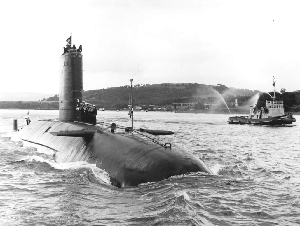| Revision as of 14:06, 14 July 2008 editDavid Biddulph (talk | contribs)Autopatrolled, Extended confirmed users, Pending changes reviewers, Rollbackers88,937 editsm Default sort← Previous edit | Revision as of 14:19, 14 July 2008 edit undoDavid Biddulph (talk | contribs)Autopatrolled, Extended confirmed users, Pending changes reviewers, Rollbackers88,937 editsm Correction to default sortNext edit → | ||
| Line 82: | Line 82: | ||
| {{Churchill class submarine}} | {{Churchill class submarine}} | ||
| {{DEFAULTSORT: |
{{DEFAULTSORT:Conqueror (S48)}} | ||
| ] | ] | ||
| ] | ] | ||
Revision as of 14:19, 14 July 2008
For other ships with the same name, see HMS Conqueror.
| |
| History | |
|---|---|
| Laid down | 5 December 1967 |
| Launched | 18 August 1969 |
| Commissioned | 9 November 1971 |
| Decommissioned | 2 August 1990 |
| Nickname(s) | "Conks" |
| General characteristics | |
| Displacement | 4,900 tonnes (submerged) |
| Length | 86.9 m |
| Beam | 10.1 m |
| Draught | 8.2 m |
| Propulsion | One Rolls-Royce PWR nuclear reactor, one shaft |
| Speed | 28 knots (submerged) |
| Range | Limited only by food stored on board |
| Complement | 103 |
| Armament | list error: <br /> list (help) 6 x 533 mm tubes capable of firing: Mark 8 torpedoes Tigerfish torpedoes RN Sub Harpoon Missiles |
HMS Conqueror ("Conks") was a Churchill-class nuclear-powered fleet submarine that served in the Royal Navy from 1971 to 1990. She was built by Cammell Laird in Birkenhead. As of 2008, she is the only nuclear-powered submarine to have engaged an enemy ship with torpedoes, sinking the cruiser ARA General Belgrano with two mark 8 torpedoes. She is one of only two submarines which have sunk a warship since World War II, the other being the Pakistani Navy's PNS Hangor.
Conqueror was the third of the class, the other two being Churchill and Courageous. The main aim of these submarines was to face the Soviet threat at sea by attacking other ships and submarines, and spying on Soviet nuclear-armed submarine movements.
However, Conqueror, commanded by Cdr Chris Wreford-Brown, was most famously deployed during the Falklands War, setting sail from Faslane Naval Base on the River Clyde in Scotland on 3 April 1982, one day after the Argentine invasion. Conqueror arrived in the exclusion zone around the Falklands twenty-one days later. She was ordered to scan the area for Argentine shipping, particularly the Argentine aircraft carrier, ARA Veinticinco de Mayo (the 25th of May). However, on 30 April, she spotted the Argentine light cruiser, ARA General Belgrano. Belgrano was sailing southwest of the Falklands, just outside the exclusion zone imposed by the British on Argentine shipping and approaching the Task Force, while the ARA Veinticinco de Mayo was approaching from the north. British admiral, Rear Admiral J. F. Woodward, requested permission from the British government to sink Belgrano. After some debate he was allowed to proceed, though while this was going on the Belgrano retired from its attack position since the ARA Veinticinco de Mayo was not ready. Finally, the message to engage the 'Belgrano' was sent from Northwood, the Royal Navy's fleet command centre in the United Kingdom to Conqueror.
The basis for this decision was that the Royal Navy feared a pincer-style attack with Belgrano attacking from the south, and the Veinticinco de Mayo from the north. Also Belgrano could have escaped from Conqueror by sailing across nearby shallow waters, and it could have then attacked the British Task Force.
The scene was now set, and on 2 May Conqueror became the first nuclear-powered submarine to fire in anger when she launched three mark 8 torpedoes at Belgrano, two of which struck the ship and exploded. Twenty minutes later, the ship was sinking rapidly and was abandoned by the crew. The two escorting destroyers fled the scene under fear of further attack. 323 men were killed.
Conqueror's war did not end there. The crew of the submarine had to face Argentine Air Force attempts to locate the boat in the days after the attack, which had shocked the Argentine people and ruling dictatorship. Conqueror did not fire again in anger throughout the war, but the crew did provide valuable help to the task force by using their sophisticated monitoring equipment to track Argentine aircraft departing the mainland.
After the war, Conqueror returned to Faslane, flying the Jolly Roger, a customary act of Royal Navy submarines after a "kill". When asked about the incident later, Cdr Wreford-Brown responded, "The Royal Navy spent thirteen years preparing me for such an occasion. It would have been regarded as extremely dreary if I had fouled it up."

Conqueror did not take part in any other official conflicts, and was decommissioned in 1990. The periscope of the submarine can be viewed in the Royal Navy's museum in Gosport.
Further reading
- Rossiter, Mike (2007). Sink the Belgrano. Bantam Press.
{{cite book}}: Text "ISBN 978-0-593-05842-8" ignored (help)
Footnotes
- Hastings, Max (1983). "Chapter 9". The Battle for the Falklands. Bungay, Suffolk: Book Club Associates. pp. p. 147.
{{cite book}}:|pages=has extra text (help); Unknown parameter|coauthors=ignored (|author=suggested) (help) - The Conqueror was also equipped with Tigerfish torpedoes but her captain chose to use the more reliable mark 8 which were a fifty year old design.
| Churchill-class submarines | |
|---|---|
| |